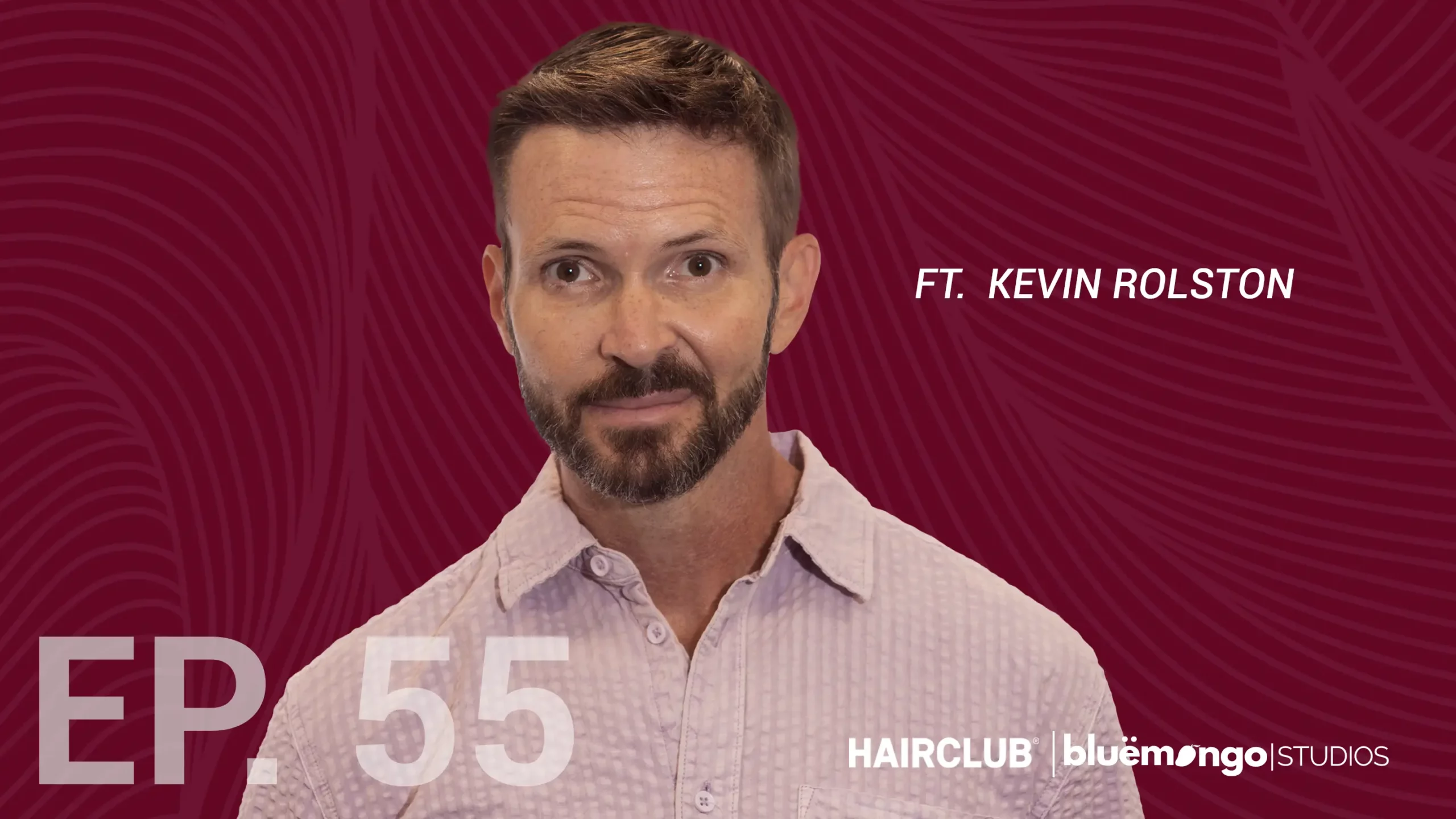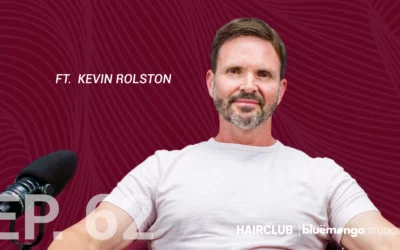Episode 55
Women’s History of Hair Loss Solutions

In honor of Women’s History Month, this week we’re focusing on the history of women’s hair loss treatments and solutions, from ancient times to cutting-edge modern-day solutions.
Women’s History of Hair Loss Treatments
Hair has always been tied to identity, beauty, and confidence, which is why hair loss in women hasn’t always been discussed openly. Ancient Egyptians used animal fats and oils in hopes of stimulating hair growth, while Roman women wore wigs often crafted from real human hair. Some of history’s so-called remedies were far from glamorous—Cleopatra’s hair loss treatment reportedly included bear grease and ground horse teeth. Even into the early 20th century, women had few options beyond hairpieces and home remedies. It wasn’t until more recent decades that medical advancements paved the way for effective treatments tailored to women’s hair loss.
Causes of Women’s Hair Loss
Hair loss in women often differs from men’s hair loss in a few key ways. Instead of receding hairlines around the forehead and temples or crown, women’s hair loss typically manifests as diffuse thinning, widening part lines, and decreased volume. The causes can vary—hormonal changes due to pregnancy, menopause, or PCOS can trigger noticeable shedding. Nutritional deficiencies, such as low iron or vitamin D, can weaken hair, while stress and autoimmune disorders may contribute to excessive hair loss. Genetic factors also play a role, as female pattern hair loss tends to develop gradually over time. The good news is that understanding the cause is the first step toward finding the right hair loss solution.
Science-Backed Hair Loss Solutions for Women
Today’s treatments offer real hope for women experiencing hair loss. Minoxidil remains the only FDA-approved topical treatment for female hair loss, helping extend the hair’s growth phase for thicker, healthier strands. Oral medications like spironolactone can help balance hormones for those whose hair loss is driven by excess androgens. Low-level laser therapy (LLLT) is another promising option, using light to stimulate hair follicles and improve scalp circulation. PRP therapy, which involves injecting platelet-rich plasma into the scalp, has gained popularity for its potential to encourage regrowth. For those seeking instant confidence, hair systems and toppers provide a natural-looking, long-term solution. Innovations like Xtrands from HairClub seamlessly integrate additional strands into existing hair, offering an immediate volume boost.
Finding the Right Solution for You
If you’re struggling with women’s hair loss, you’re not alone. Over 50% of women will experience some degree of hair thinning in their lifetime, but there are more options than ever before. Whether it’s a medical treatment, a cosmetic solution, or a combination of both, the best approach depends on the cause of your hair loss and what fits your lifestyle. To hear firsthand stories from women who have found success, check out our past episodes featuring Meg Weatherman and Carol Combs (links below). No matter where you are on your hair journey, solutions exist—and there’s hope.
Empowering Resources
Book a Complimentary HairClub Consultation Today!
Thanks for listening to HairPod. We hope you enjoyed this episode. If you did, please leave us a rating or review wherever you get your podcasts. If you’d like to connect with us on social media to share your story, check us out on Instagram @HairClub. HairPod is a production of TSE Studios. Our theme music is from SoundStripe.
Episode.55 Transcript
Kevin Rolston [00:00:02]
If you’re experiencing hair loss, the most important thing we want you to know is that you’re not alone and that there are answers out there. The first step is to understand what’s causing your hair loss, and the next is to look at the options that are going to be right for your lifestyle and budget. Whether it’s a topical solution, a professional treatment, or just the reassurance that you’re not the only one going through this, there’s hope.
Kevin Rolston [00:00:38]
Welcome to HairPod, the podcast where we talk about all things hair loss. I’m your host, Kevin Rolston, and this week, we’re celebrating Women’s History Month by taking a look at the evolution of hair loss solutions for women and the most effective solutions that are on the market right now. Maybe you’ve been noticing a little bit more hair coming out in the shower or some whitening around your part.
Kevin Rolston [00:01:00]
Maybe your hair tie or scrunchie is starting to feel looser than it used to when you put your hair up at a ponytail, or maybe you’re not sure if you’re experiencing hair loss, but you want to make sure that you’re doing everything you can to keep your hair healthy and strong. Studies show that over 50% of women will experience some hair thinning over the course of their lives. So the first and most important thing to remember is that you’re not the only one going through this.
Kevin Rolston [00:01:25]
And I think the second most important thing is to know is that there are so many different ways to handle your hair loss that can make a big difference in how you look and feel. The rest of today’s episode is all about understanding the journey of women’s hair loss, how it’s been perceived throughout history, what causes it, and most importantly, how far our current hair loss solutions have come. For as long as humans have cared about their appearance, hair has been a symbol of beauty, health, and identity, especially for women.
Kevin Rolston [00:01:55]
And because of that, hair loss has historically been a sensitive subject often swept under the rug. Ancient Egyptian women used castor oil and animal fats to keep their hair thick and strong, believing that certain oils had special growth properties. In ancient Rome, women wore elaborate wigs made from real human hair.
Kevin Rolston [00:02:14]
According to the UK Institute of Trichologists, Cleopatra’s personal hair loss remedy was a pretty horrifying concoction that included ground-up horse teeth and bear grease, which besides being extremely gross, didn’t really work. It just goes to show that people have always been trying to solve the problem of hair loss and have been willing to do whatever it takes if they think it means getting their hair back. Fast forward to the early 20th century, and there still wasn’t much available in terms of medical solutions for women’s hair loss.
Kevin Rolston [00:02:47]
Hairpieces and home remedies dominated, but the idea of restoring hair loss wasn’t considered viable for women until fairly recently. Now, we’re in an era where medical science has caught up and women have access to real effective solutions. Hair loss in women doesn’t have to look the same as it does in men.
Kevin Rolston [00:03:10]
Instead of a receding hairline or bald spots, most women experience diffused thinning, where the hair gradually becomes finer, the part line widens, and overall volume decreases. This can happen for a lot of different reasons. Hormonal changes are a big one.
Kevin Rolston [00:03:27]
Pregnancy, menopause, and conditions like PCOS can all cause noticeable thinning. Nutritional deficiencies, like how iron or vitamin D can weaken the hair. Stress and autoimmune disorders can also trigger sudden or excessive shedding.
Kevin Rolston [00:03:41]
And then there’s genetics. Female pattern hair loss and androgenetic alopecia is hereditary and tends to progress gradually over time. But here’s the good news.
Kevin Rolston [00:03:52]
Hair loss is no longer a life sentence. There are real science-backed solutions for women who want to slow, stop, or even reverse thinning hair. One of the most well-known treatments is minoxidil.
Kevin Rolston [00:04:03]
It’s the only FDA-approved topical treatment for female hair loss. Every hair follicle on your head goes through a cycle where it grows hair, then rests, then sheds. Minoxidil works by extending the hair’s growth phase so that more hair follicles are staying active for longer.
Kevin Rolston [00:04:21]
It doesn’t give instant results, but with consistent use, many women see a noticeable difference over several months. Minoxidil is available over the counter in both liquid and foam forms, and it’s easy to integrate into your daily routine. For some women, oral medications that help balance hormones can make a difference.
Kevin Rolston [00:04:39]
Spironolactone is a prescription medication that blocks androgens, which are the male hormones that can contribute to hair thinning in women with hormonal imbalances. This medication isn’t for everyone. So if you’re concerned that you might fit into this category, it’s important to talk to your doctor and see if you’re a candidate.
Kevin Rolston [00:04:57]
Part of healthy hair growth is the gentle stimulation of hair follicles. Maybe you’ve heard of laser hair removal, but low-level laser therapy, or LLLT, can actually help improve your hair growth and health. This treatment uses low-intensity light to stimulate hair follicles and improve blood circulation to the scalp.
Kevin Rolston [00:05:16]
It’s noninvasive and completely painless, and there are laser caps and combs available for at-home use. The results aren’t instant, and it requires consistent use over time, but some studies suggest it can help slow hair thinning and encourage new growth. Another emerging treatment is platelet-rich plasma therapy, or PRP.
Kevin Rolston [00:05:41]
This is a procedure where a doctor takes a small sample of your own blood, processes it to extract platelet-rich plasma, and then injects it into the scalp. The idea is that platelets contain growth factors that can stimulate hair follicles. PRP therapy has gained popularity in recent years and has shown promise for some women experiencing thinning hair.
Kevin Rolston [00:06:02]
However, it does require multiple sessions and results can vary. For women who want something to improve their confidence while they’re using these products, or just like the feeling of instant gratification, there are products like Xtrands from HairClub, which involve adding hundreds, if not thousands, of hairs to your existing hairs. Before threading these hairs in one by one, an expert stylist takes the time to match your hair color and texture so that the new hairs blend in seamlessly.
Kevin Rolston [00:06:32]
And then once they’re in, they truly become your hair. You can wash, shampoo, and style all of your hair just like you normally would. And of course, there are hair systems and toppers.
Kevin Rolston [00:06:43]
Today’s options are nothing like the heavy, unnatural-looking wigs of the past. High-quality hair systems are made with real human hair and breathable caps that allow for a realistic and comfortable fit. And the use of medical-grade adhesives will keep your hair system attached no matter what.
Kevin Rolston [00:07:01]
Many women who have advanced hair loss due to conditions like alopecia universalis or hair loss due to chemotherapy will embrace these options as permanent solutions. And if you wanna hear some stories about women who have found a way to navigate their hair loss and use the latest and greatest technology to look and feel like themselves again, check out our episode with Meg Weatherman and her experience dealing with trichotillomania, or Carol Combs, who found a hair loss solution after getting through chemo. You can find a link to these episodes in our show notes.
Kevin Rolston [00:07:32]
If you’re experiencing hair loss, the most important thing we want you to know is that you’re not alone and that there are answers out there. The first step is to understand what’s causing your hair loss. And the next is to look at the options that are going to be right for your lifestyle and budget, whether it’s a topical solution, a professional treatment, or just the reassurance that you’re not the only one going through this.
Kevin Rolston [00:07:55]
There’s hope. Thank you for tuning in to this special Women’s History Month episode of HairPod. Check us out at HairClub on Instagram or search HairPod on Facebook to continue the conversation.
Kevin Rolston [00:08:10]
If you know someone who could benefit from hearing this episode, we would love it if you would share it with them. If you’re enjoying the show, consider leaving us a rating and review on Apple Podcasts or your favorite podcast app. We also have a website.
Kevin Rolston [00:08:23]
Check it out by going to podcast.hairclub.com. We’re here to build people up and share real stories so people experiencing hair loss feel a little bit less alone. And when you share, review, and subscribe, it helps us do just that. So thank you. Until next time.
Featured Guests
New Episodes Weekly
Available Every Tuesday @ 9am
Want to Be a Guest?
Related Episodes
Living the Fast Life: Work, Family, and HairClub
Joey Logano on NASCAR wins, playoff pressure, and how HairClub helps him stay confident on and off the track.
Lights, Camera, Confidence
HairPod goes visual! Watch our first-ever video episode as we wrap season one and share what’s next with special guest Donald Kelly.





